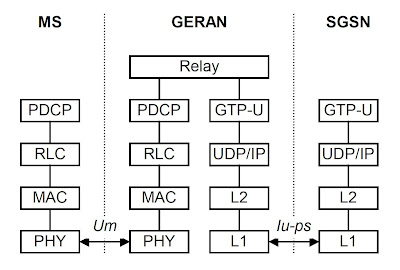
EDGE, Enhanced Data rates for GSM Evolution, is a further step for GSM to migrate to 3G. It uses a new air-interface technology -- 8 Phase Shift Keying Modulation (8-PSK) to offer 48 kbits/s per GSM timeslot. The overall offered data speeds of 384Kbps places EDGE as an early pre-taste of 3G and it is actually labeled as 2.75G by the industry.
EDGE is occasionally referred to as Enhanced GPRS (EGPRS) because it increases the capacity and data throughput of GPRS by three to four times. Like GPRS, EDGE is a packet-based service, which provides customers with a constant data connection.
1. EDGE Network Architecture
On top of the GPRS network, it is only necessary to upgrade the MS and the radio access network RAN (BTS + BSC) to support the EDGE functionalities. The RAN for EDGE is referred as GERAN (GSM/EDGE Radio Access Network).

2. EDGE Network Entities
All EDGE network entities are same as those of GPRS except that the MS and the BTS are upgraded with new physical layers to support the new modulation technology. Some industrial notations also included the migration of BSC to RNC (Radio Node Controller) into the EDGE for the new Iu-cs and Iu-ps interface support.
3. EDGE Interfaces and Protocols
Besides all other interfaces that are common with GPRS, the EDGE specific interfaces are between the BSC/RNC and SGSN. Between these two network entites, both the GPRS Gb and the new Iu-ps interfaces are supported. The protocol stacks of the Iu-ps interface control plane and user plane are as below.
Iu-ps Control Plane Protocol Stacks

Iu-ps User Plane Protocol Stacks

4. EDGE Evolution
EDGE Evolution is an upgraded version of EDGE that completed standardization work in 2007 within Release 7 at 3GPP. EDGE Evolution is also referred to as EDGE II or Evolved EDGE by some industry sources. EDGE Evolution boosts the data speeds by up to 300 percent and significantly improves latency, coverage, and spectrum efficiency of existing GSM/EDGE equipment.
Compared to EDGE, EDGE Evolution is expected to provide:
• A dramatic increase in data rates. The actual amount depends on the version used, but EDGE Evolution is expected to quadruple the throughput rates for EDGE with peak theoretical network speeds of 1184 kbps to 1894 kbps in type 1 or type 2 respectively for the downlink and 473 to 947 kbps for the uplink.
• A 50 percent increase in spectral efficiency and capacity
• Reduced latency for initial access and round trip time, enabling better quality of service (QoS) for Push-to-Talk (PTT) and Voice over IP (VoIP)
• Compatibility with existing frequency plans, thus facilitating rapid deployment in existing networks
• A simple upgrade to existing GSM equipment allowing a more efficient use of scarce existing spectrum
• A better seamless experience for subscribers as they roam from HSPA networks to EDGE networks
• Compatibility with existing frequency plans, thus facilitating rapid deployment in existing networks